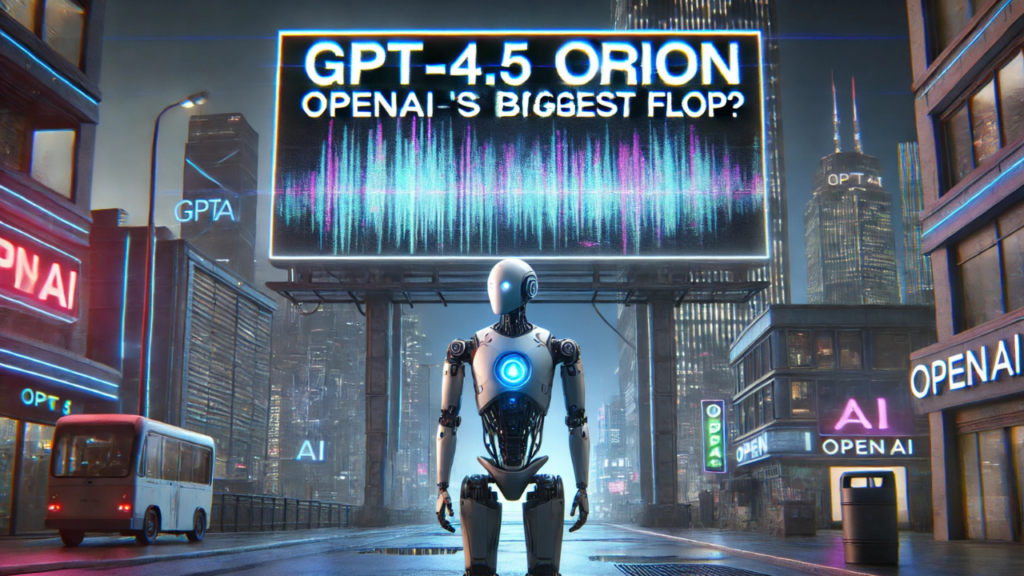Introduction
OpenAI just launched GPT-4.5 Orion, its biggest and most expensive AI model ever. But despite the hype, the reality is disappointing. The reviews are in, and they paint a grim picture. Many experts are calling it a failure.
OpenAI is burning through cash at an unsustainable rate. They are out of GPUs. Each AI interaction costs them money. It looks like the “bigger is better” strategy for AI is reaching its breaking point.
So, what does this mean for the future of AI? Let’s dive in.
1. The Mega-Model That Doesn’t Deliver
When OpenAI announced GPT-4.5 Orion, expectations were sky-high. AI enthusiasts hoped for better accuracy, faster response times, and improved reasoning. But the reality is different.
Performance Issues
- Users report minimal improvements over GPT-4.
- Longer response times frustrate users.
- It struggles with real-time processing.
- Complex queries generate inconsistent results.
Why the Disappointment?
GPT-4.5 Orion is massive, requiring enormous computing power. But bigger models don’t always mean better results. Many users expected a game-changing upgrade but got a barely improved version instead.
Even worse, the costs to run it are skyrocketing. OpenAI is losing money with each query. This raises serious concerns about AI sustainability.
Many developers and businesses rely on AI tools for automation, research, and productivity. But if AI models continue to become more expensive while showing diminishing returns, businesses may start looking for alternative solutions.
Companies using AI-powered tools need reliability. If AI models require too much infrastructure to function properly, they may no longer be viable for smaller businesses and startups. This could lead to a shift in the industry’s direction.
2. The Cracks in OpenAI’s Strategy
OpenAI has positioned itself as the leader in AI research. But its current path is showing signs of failure.
Financial Struggles
- Running GPT-4.5 Orion costs millions per day.
- OpenAI is spending more than it earns.
- The company relies heavily on funding to stay afloat.
- Investors are beginning to question the sustainability of AI at this scale.
GPU Shortage and Infrastructure Issues
- AI models require GPUs, but supply is running low.
- OpenAI is struggling to get enough hardware.
- The global semiconductor shortage is adding pressure.
- Scaling AI requires more power than current infrastructure can support.
Every Query Is a Loss
- More complex models require more processing power.
- Each interaction costs OpenAI money.
- This raises concerns about long-term profitability.
- If OpenAI fails to monetize its models, AI development could slow down.
All these challenges suggest that OpenAI’s business model is unsustainable. If they can’t fix these issues, AI advancements may slow down.
Big tech companies such as Google and Microsoft have also invested heavily in AI. If OpenAI struggles, the competition may step in with alternative solutions. However, these companies also face similar challenges with scaling AI efficiently.
3. The Scaling Hypothesis Hits a Wall
For years, AI experts believed scaling models was the key to better AI. But this approach is now showing its limits.
Lessons from Past Tech Trends
- In the early 2000s, CPUs hit a limit on clock speeds.
- The industry shifted to multi-core processors instead.
- AI may need a similar shift in approach.
- Companies that adapt to this shift will lead the next AI revolution.
Why Scaling Isn’t Working Anymore
- Bigger models require more power and hardware.
- Cost increases are unsustainable.
- Diminishing returns are evident with GPT-4.5 Orion.
- Training massive models takes longer and consumes more resources.
A Need for a New Approach
- AI research must focus on efficiency, not just size.
- Alternative models may be the future.
- Smaller, specialized AIs could be more effective.
- New architectures like modular AI could replace monolithic models.
The AI industry needs a new direction. Relying on larger models is becoming inefficient and costly. If companies don’t innovate beyond size, AI progress may stall.
4. What This Means for the Future of AI
The failure of GPT-4.5 Orion raises big questions about AI’s future.

Is the “Bigger is Better” Era Over?
- Companies may shift to smaller, more optimized models.
- AI research may focus on efficiency rather than size.
- The industry might explore hybrid AI approaches.
- Decentralized AI networks could become more popular.
The Need for New Innovations
- AI needs better data processing, not just more parameters.
- Energy-efficient AI models will be a priority.
- Companies may invest in modular AI architectures.
- Edge computing and AI miniaturization could shape the next phase of AI.
OpenAI’s Next Steps
- Can they make AI profitable?
- Will they shift focus to smaller, cost-effective models?
- How will they address hardware shortages?
- Will they pivot to different AI applications to sustain revenue?
The AI race isn’t over, but OpenAI needs to rethink its strategy. If they continue down this path, AI progress could stagnate, and competitors may take over.
Conclusion
GPT-4.5 Orion’s release proves one thing: scaling AI endlessly is not the answer. OpenAI is facing financial struggles, hardware shortages, and increasing inefficiencies. The industry must explore alternative paths.
The next wave of AI innovation may focus on efficiency, adaptability, and cost-effectiveness. The hype around massive models might be fading, and a new era of AI could be emerging.
The AI world is at a crossroads. Will OpenAI and its competitors find a way forward? Stay tuned for more insights on StartupHakk.




